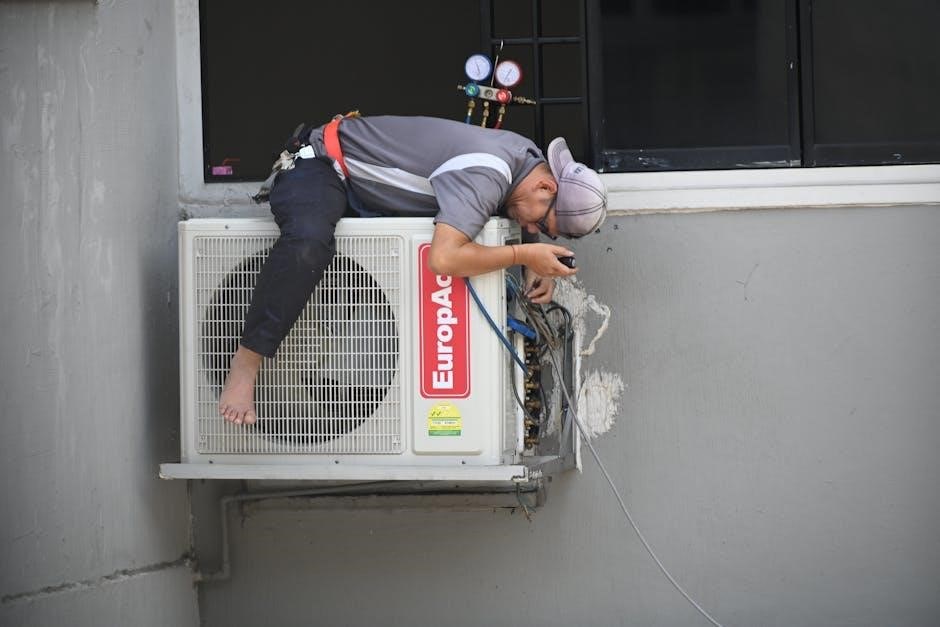An HVAC installation checklist is a comprehensive guide ensuring efficient and safe system setup. It outlines pre-installation tasks, compliance with standards like ASHRAE, and essential components for a successful installation process.
1.1 Purpose of the Checklist
The purpose of an HVAC installation checklist is to ensure a systematic and efficient approach to installing heating, ventilation, and air conditioning systems. It serves as a visual reference guide, helping technicians and contractors adhere to industry standards, such as ASHRAE 62.2-2010, and manufacturer guidelines. By following the checklist, professionals can minimize errors, ensure compliance, and verify that all components are installed correctly. The checklist also aids in verifying that the system meets design specifications, operates safely, and maintains energy efficiency. It covers tasks from pre-installation inspections to final testing, ensuring a thorough and professional job. This tool is essential for maintaining quality, reducing callbacks, and improving overall customer satisfaction.
1.2 Importance of a Checklist
A checklist is crucial for ensuring a smooth and error-free HVAC installation process. It helps technicians systematically verify each step, from pre-installation inspections to final testing, minimizing oversights and ensuring compliance with standards like ASHRAE. By following a checklist, contractors can avoid common issues such as incorrect sizing, improper connections, and safety hazards. This tool also enhances professionalism, as it demonstrates a commitment to quality and attention to detail. Additionally, a checklist streamlines communication between technicians and customers, providing transparency and building trust. It serves as a legal and operational safeguard, ensuring all installations meet local building codes and manufacturer requirements. Regular use of a checklist can improve efficiency, reduce callbacks, and ultimately lead to higher customer satisfaction and system performance. Its importance cannot be overstated in maintaining consistency and excellence in HVAC installations.
1.3 Key Components Included
An HVAC installation checklist typically includes essential components to ensure a thorough and accurate setup. These components cover pre-installation tasks such as space inspection, unit inspection, and system design verification. They also address technical aspects like ductwork preparation, electrical and plumbing readiness, and compliance with standards like ASHRAE. Additionally, the checklist includes functional testing of components, airflow and ventilation checks, and final system inspection. Other critical elements are control checks and calibration, ensuring proper system operation. Documentation and compliance requirements are also highlighted to maintain accountability. These components collectively ensure that every step of the installation process is methodically executed, minimizing errors and ensuring optimal system performance. By organizing these elements, the checklist provides a clear roadmap for contractors and technicians to follow, guaranteeing a professional and reliable installation. Each component plays a vital role in achieving a successful and efficient HVAC setup.

Pre-Installation Tasks and Preparation
Pre-installation tasks involve reviewing project specifications, conducting site visits, and assessing system design. Ensuring safety protocols and proper unit inspections are critical before beginning the installation process.
2.1 Project Specifications and Requirements
Project specifications and requirements are the foundation of a successful HVAC installation. These documents outline the scope, design, and technical details necessary to meet the client’s expectations and ensure compliance with local building codes and standards.
Key elements include system capacity, equipment models, and specific features tailored to the space’s needs. ASHRAE standards, such as ASHRAE 62.2-2010, often serve as a benchmark for ventilation and indoor air quality, ensuring the system’s performance and efficiency.
Reviewing these specifications before installation helps technicians identify potential challenges, such as duct sizing or electrical requirements, and ensures that all components are compatible and properly sized for the space.
Failure to adhere to these requirements can result in system inefficiencies, safety hazards, or even non-compliance with regulatory standards, emphasizing the importance of thorough preparation and planning.
2.2 Site Visit and Assessment
A site visit and assessment are critical steps before beginning any HVAC installation. This process involves evaluating the installation location to ensure it meets the system’s requirements and identifies potential challenges.
During the visit, technicians inspect the space layout, existing ductwork, and electrical connections. They verify that the area is clear of obstructions and that all necessary utilities are accessible and functional.
The assessment also includes checking for any structural or environmental factors that could impact installation, such as moisture levels, ventilation, or safety hazards. This step ensures that the installation plan is tailored to the specific site conditions.
Documentation of the site visit helps in creating a detailed installation plan, reducing the risk of delays or unforeseen issues during the process. It also ensures that the system is installed safely and efficiently, meeting both the client’s expectations and regulatory standards.
This step is essential for a smooth and successful installation, as it lays the groundwork for all subsequent tasks.
2.3 Pre-Installation Unit Inspection
A pre-installation unit inspection is a crucial step to ensure that the HVAC equipment is in optimal condition before installation begins. This involves checking the unit for any visible damage, such as dents or scratches, that may have occurred during shipping or storage.
Technicians inspect the internal components, including coils, fans, and controls, to verify that they are intact and functioning properly. They also check for any signs of corrosion or wear, which could affect performance and longevity.
The inspection includes verifying that all necessary accessories, such as belts, filters, and wiring, are included and compatible with the system. This step ensures that the unit is ready for installation and reduces the likelihood of post-installation issues.
Documentation of the inspection is typically recorded in the HVAC installation checklist, providing a clear record of the unit’s condition before installation. This helps in addressing any potential issues early and ensures a smooth installation process.
This thorough inspection is essential for maintaining the quality and reliability of the HVAC system, ensuring it operates efficiently and meets the client’s expectations.
System Quality Installation Standards
System quality installation standards ensure HVAC systems meet specified performance, safety, and efficiency requirements, adhering to guidelines like ASHRAE and manufacturer recommendations for optimal functionality and reliability.
3.1 Compliance with ASHRAE Standards
Compliance with ASHRAE standards is crucial for ensuring HVAC systems meet established guidelines for ventilation, thermal comfort, and energy efficiency. ASHRAE Standard 62.2-2010 specifically addresses ventilation system design, requiring proper airflow rates and duct sizing to maintain indoor air quality. During installation, technicians must verify that the system design aligns with these standards, including the correct installation of intake and return ducts. Additionally, the system should not rely solely on the return side for ventilation, ensuring balanced airflow. Adhering to these standards not only improves system performance but also contributes to occupant health and comfort. Contractors must ensure all components, such as belts and controls, are installed correctly and functioning as intended to meet ASHRAE requirements. This step is vital for achieving a safe and efficient HVAC installation.
3.2 Design and Capacity Considerations
Proper design and capacity considerations are essential to ensure the HVAC system meets the specific needs of the space. This includes accurately calculating the heating and cooling loads based on factors like room size, insulation, and occupancy. The system’s design must align with the building’s layout, ensuring adequate airflow distribution through properly sized ductwork. Oversized or undersized units can lead to inefficiency, increased energy costs, and potential safety hazards. Technicians should verify that the selected equipment matches the calculated load requirements and is compatible with existing infrastructure; Additionally, the system’s design should account for future flexibility, allowing for potential upgrades or changes in usage. Adhering to these considerations ensures optimal performance, energy efficiency, and long-term reliability of the HVAC installation.
3.3 Control Checks and Calibration
Control checks and calibration are crucial for ensuring the HVAC system operates efficiently and effectively. During installation, technicians must verify that all controls, including thermostats, sensors, and control panels, are functioning correctly. Calibration involves setting precise parameters to ensure the system responds accurately to temperature changes and maintains optimal performance. Proper calibration prevents issues like overheating or insufficient cooling, which can lead to discomfort and increased energy consumption. Technicians use specialized tools and procedures to adjust and test controls, ensuring they meet manufacturer specifications and local building codes. Regular calibration is essential not only during installation but also during routine maintenance to maintain efficiency and extend the system’s lifespan. Accurate control settings contribute to energy savings and system reliability, making them a vital part of the HVAC installation process.

Space and Site Preparation
Space and site preparation ensures a safe and efficient installation environment. Assess the area for ductwork, electrical, and plumbing readiness, and ensure the site is clear, accessible, and safe for work.
4.1 Space Assessment for Installation
Space assessment for installation is crucial to ensure the HVAC system fits and functions properly. Evaluate the area for ductwork placement, electrical connections, and plumbing accessibility. Check for obstructions, proper ventilation, and structural integrity. Verify that the space meets manufacturer specifications for unit dimensions and clearance. Ensure the site is clean, dry, and free from hazards to prevent installation delays. Assess the layout to determine the optimal placement of components for efficiency and accessibility. Confirm that all necessary utilities are available and functional. Proper space assessment ensures a smooth installation process and minimizes potential issues post-installation. This step is vital for both residential and commercial setups to guarantee system performance and safety. Always refer to the HVAC installation checklist to cover all aspects of space preparation thoroughly. A well-prepared site ensures efficient and safe installation, adhering to industry standards and manufacturer guidelines.
4.2 Ductwork Inspection and Preparation
Ductwork inspection and preparation are essential steps in HVAC installation. Inspect existing ducts for leaks, damage, or obstructions. Ensure all joints are sealed properly and that insulation is adequate. Verify duct sizing matches the system requirements for optimal airflow. Clean ducts thoroughly to remove debris and contaminants. Check for proper ventilation openings and ensure they are unobstructed. Measure duct static pressure to confirm it aligns with system specifications. Replace any damaged or corroded sections to maintain efficiency. Ensure all access points are clear for easy maintenance. Proper ductwork preparation prevents issues like poor airflow, increased energy costs, and system malfunction. Refer to the HVAC installation checklist to ensure all duct-related tasks are completed before proceeding. A well-prepared duct system guarantees efficient heating, cooling, and ventilation, enhancing overall system performance and longevity. Addressing ductwork issues early ensures a smooth and effective installation process.
4.3 Electrical and Plumbing Readiness
Ensuring electrical and plumbing readiness is a critical step in HVAC installation. Verify that all electrical connections are secure, with appropriate voltage and amperage ratings matching the system requirements. Check circuit breakers and fuses to ensure they are functioning correctly. Confirm that all necessary switches, outlets, and wiring are installed and meet local codes. For plumbing, inspect water supply lines, drains, and condensate disposal systems for leaks or blockages. Ensure proper sizing and material of pipes for optimal performance. Verify that gas lines, if applicable, are correctly installed and tested for leaks. Make sure all shut-off valves are accessible and functioning. Review the HVAC installation checklist to confirm electrical and plumbing systems are ready for the new equipment. Proper preparation prevents delays, safety hazards, and potential system damage, ensuring a smooth installation process and efficient operation.

Contractor and Technician Responsibilities
Contractors and technicians must ensure safe installations, follow manufacturer guidelines, and secure all connections. They are responsible for proper system setup, adhering to codes, and completing documentation accurately.
5.1 Evaluating Contractor Capabilities
Evaluating contractor capabilities is crucial to ensure a reliable and high-quality HVAC installation. A checklist helps assess a contractor’s credibility, experience, and ability to meet project requirements. It includes reviewing their understanding of the project, compliance with standards like ASHRAE, and adherence to safety protocols. Additionally, the checklist evaluates their ability to provide detailed proposals, including system design, material quality, and installation timelines. It also assesses their communication skills and willingness to address client concerns. By systematically evaluating these factors, homeowners and businesses can select a contractor who aligns with their needs and ensures a successful installation. This step is vital to avoid potential issues and ensure the system performs efficiently and safely. A thorough evaluation guarantees that the contractor possesses the necessary expertise and resources to deliver a professional installation.
5.2 Technician’s Pre-Installation Checklist
A technician’s pre-installation checklist ensures all necessary steps are taken before starting the HVAC system setup. It includes verifying the space’s readiness, inspecting the unit for damage, and ensuring all components are compatible. The checklist also involves reviewing manufacturer guidelines, checking ductwork for leaks or obstructions, and confirming electrical and plumbing connections are in place. Additionally, it covers verifying system controls, calibrating sensors, and ensuring safety protocols are followed. Proper documentation of findings and addressing any issues before proceeding is essential. This systematic approach helps technicians avoid installation errors, ensuring the system operates efficiently and safely. By following the checklist, technicians can identify potential problems early, saving time and resources. It also ensures compliance with industry standards and manufacturer recommendations, guaranteeing a smooth installation process. This step is critical for delivering a high-quality installation that meets customer expectations.
5.3 Documentation and Compliance
Proper documentation and compliance are critical throughout the HVAC installation process. Technicians must ensure all installation steps are recorded, including system tests, inspections, and calibrations. Compliance with industry standards like ASHRAE and local building codes is mandatory to guarantee safety and efficiency. Documentation should include equipment manuals, test results, and a final inspection report. Contractors must provide a copy of the completed checklist to the customer, verifying that the installation meets all requirements. This documentation serves as proof of a job well done and ensures accountability. Compliance also involves adhering to manufacturer guidelines and safety protocols, which are essential for system performance and longevity; By maintaining thorough records, contractors and technicians can demonstrate their commitment to quality and professionalism, ultimately protecting both parties from potential disputes. Accurate and detailed documentation is the cornerstone of a compliant and successful HVAC installation.

System Testing and Commissioning
This phase ensures the HVAC system operates efficiently and safely. Functional testing of components, airflow checks, and a final inspection are conducted to verify proper system operation and performance.
6.1 Functional Testing of Components
Functional testing ensures each HVAC component operates as intended. This includes verifying thermostat accuracy, checking if blowers and compressors start and run smoothly, and confirming proper operation of dampers and valves. Technicians also test safety features, such as limit switches and pressure switches, to ensure they activate correctly during abnormal conditions. Additionally, they check for proper gas ignition and combustion in furnaces, ensuring no leaks or carbon monoxide production. Electrical connections are tested for voltage and amperage, and controls are calibrated to meet manufacturer specifications. Proper refrigerant flow is verified, and any alarms or error codes are addressed. This step ensures the system is both efficient and safe, meeting all design and operational requirements before final commissioning.
6.2 Airflow and Ventilation Checks
Airflow and ventilation checks ensure proper system performance and indoor air quality. Verify unobstructed return duct sizes and check for air leaks in ductwork. Ensure ventilation systems meet ASHRAE 62.2-2010 requirements, providing adequate airflow rates. Inspect fans, belts, and motors for proper operation and alignment. Check for correct installation of grilles, registers, and dampers to ensure balanced airflow. Test ventilation controls to confirm they maintain proper indoor air quality. Measure airflow at vents using anemometers or flow hoods to ensure design specifications are met. Address any blockages or obstructions in ducts or vents. Ensure all safety devices, such as pressure switches, function correctly during operation. Proper ventilation ensures energy efficiency, comfort, and compliance with building codes, making this step crucial for a successful HVAC installation.
The final system inspection ensures all components are installed correctly and functioning as intended. Review the entire system for compliance with installation standards and manufacturer guidelines. Check for proper connections, secure fasteners, and absence of leaks in refrigerant lines and ductwork. Verify that all safety devices, such as pressure switches and belt guards, are installed and operational. Ensure controls are calibrated and functioning correctly, with sequences aligned to system requirements. Inspect electrical connections to confirm they meet local codes and are safely installed. Check for proper system startup and shutdown procedures. Validate that all components, including thermostats and sensors, are correctly configured. Ensure the system operates within specified parameters for temperature, humidity, and airflow. Address any issues identified during testing and commissioning. This final inspection ensures the HVAC system is safe, efficient, and ready for long-term operation, providing optimal performance and comfort.6.3 Final System Inspection